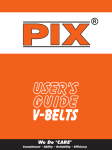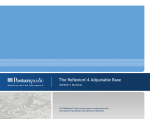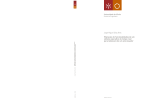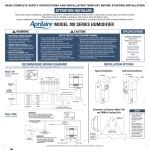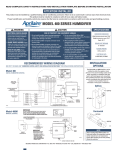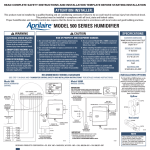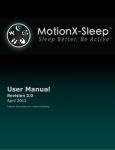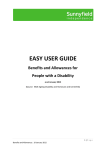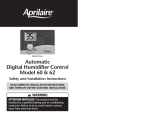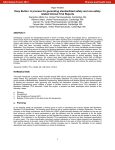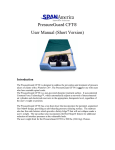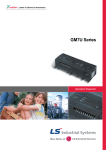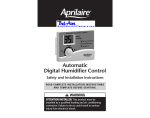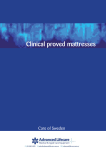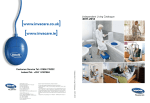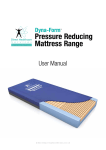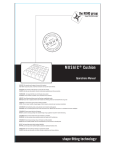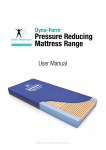Download Pressure Care Mattresses and Overlay Clinical Criteria
Transcript
Pressure Care Mattressses Clinical Criteria This criteria has been developed in consultation with expert clinicians and is based on available evidence at the time of development. This document is designed to specify the criteria to access assistance through EnableNSW for this group of assistive technology, and provide a basis for consistent and transparent decision making. PRESSURE CARE MATTRESSES see separate guide for pressure care cushions and sleep positioning equipment Included Equipment Group 1 Foam mattresses Foam overlays Group 2 alternating air mattress overlay alternating air mattress replacement powered static air mattresses air-flotation mattresses gel pads / polymer mattress sections low air loss mattress Eligible Prescribers Occupational Therapist, Registered Nurse, Physiotherapist Occupational Therapist, Registered Nurse with >1 year experience + 3 previous prescriptions for group 2 equipment in this category Exclusions Non-disability specific mattresses (e.g. innerspring, latex, Tempur foam mattresses) Non-disability specific overlays (eggshell, sheepskin, silicore fibre) Companion mattresses for a partner without a disability Double and queen sized mattresses Heel wedges, boots, elbow protectors, etc Equipment Allocation If the person lives within the Equipment Allocation Program (EAP) catchment Program (EAP) area (see website – Equipment Allocation Program tab for a list of areas) a stock item should be considered in the first instance. Contracts in place State government contract 217A pressure care mattresses If the person does not live within the EAP catchment area or a stock item is not suitable, items on NSW Health contract should be considered in the first instance, as per the Premier’s Memorandum. Availability of equipment FlexEquip (www.flexequip.com.au) - please be aware these are short term under other services loans only Ineligible Groups People who are eligible for services and equipment to be provided under any of the following will not be eligible to receive equipment through EnableNSW (see EnableNSW Policy). ADHC owned and operated supported accommodation facilities Respite or temporary care facilities Transitional Aged Care Package Federally funded Home Care Packages (levels 1-4) Motor Accidents Authority Lifetime Care and Support Authority Dust Disease Board Pressure Care Mattresses Clinical Guidelines v1 May 2014 -1- Department of Veteran’s Affairs Gold Card holder Department of Veteran’s Affairs White Card holder if the requested assistive technology is for an injury/condition developed during/or as a result of time in service Third party/Worker’s Compensation/other compensation related to the injury/disease Equipment Eligibility Criteria A pressure mattress may be funded when: Someone is at risk of a pressure injury as evidenced by sound clinical reasoning documented on the Equipment Request Form and a validated risk assessment tool and Their pressure injury risk is unlikely to significantly change and The risk cannot be mitigated by other pressure management techniques and/or equipment. The equipment prescribed will be required long term post acute treatment / healing stage of existing pressure injury. Key information to consider or include in the Equipment Request Form (ERF) Equipment Justification Provide: History/background of pressure care related to current condition including Cause Staging / classification of injury (Stage to be in line with the National Pressure Ulcer Advisory Panel (NPUAP)) Location(s) Duration / timeline of the current pressure injury(s) if applicable Information on whether the pressure injury was related to the previous/current pressure mattress Any other pressure care equipment in place e.g. pressure cushions etc. Results of a validated pressure area risk assessment tool including the score, risk category (low / medium / high / very high; at risk / not at risk, etc.) and how all of the risk factors relevant to the need for a pressure mattress are being addressed. Examples of risk assessment tools include: Waterlow, Braden, Braden Q (for children), Norton, Pressure Sore Prediction Score (PSPS), Ramstadius Note: For clinicians not familiar with pressure injury risk assessment tools, it is recommended that training and supervision is undertaken. For clinicians with the majority of their caseload rated as high risk as a result of their disability e.g. Spinal Cord Injury (SCI), the need to supply a risk scale score is optional Confirm: Investigation and outcomes of other pressure management techniques which were considered to mitigate the risk. For example For continence issues– continence assessment referral and/or any continence aids / medication / interventions in place For immobility – trial of a sustainable routine of weight shifting / repositioning self with assistance / with equipment For weight / nutrition related issues – involvement (past or present) of dietician and/or nutritionist For spasticity and movement disorders – consideration of options for medication management, slide sheets for transferring, or other equipment to reduce shearing forces / friction Trial of other items such as heel wedges or other off-loading techniques, boots, elbow protectors, etc. to address specific risk areas Pressure Care Mattresses Clinical Criteria 30 May 2014 -2- Functional Status Provide: Information from the clinical assessment including (where relevant): bed mobility sitting balance transfer techniques and abilities and risk of falls associated with recommended equipment amount of time spent in bed objective information regarding quality of sleep and how this may relate to daily activities and abilities cognitive and/or psychosocial factors that may impact on pressure care needs contributing factors such as change in health condition / prognosis impact of mattress on pain levels Confirmation that: The recommended mattress is matched with the person’s current and future pressure care needs, transfer technique, and comfort levels have been considered to ensure compliance with mattress use. The person and / or carer is able to identify equipment failure and organise repairs There are no medical contra-indications e.g. use of alternating air mattresses with unstable spinal fractures Social / Carer criteria Provide: Information regarding carer factors including: Physical abilities and / or stress related to interrupted sleep (when the device is recommended to reduce repositioning of the person) Confirmation that: The carer is trained and able to use the equipment safely including set up, care, and identifying and arranging repairs Consider: Whether the prescribed mattress / overlay will be compatible if a partner sleeps in the same bed Environmental and Equipment Factors Confirm: Person’s weight is within the safe work load of the equipment requested The size of the mattress is compatible with other bed equipment and accessories. E.g. the height of the bed rails/poles in relation to the height of the mattress, the mattress is a good fit to the mattress platform and entrapment risks have been considered Person has been informed regarding the contraindications of placing items (e.g. continence products, sheepskins, electric blankets, ill-fitting bed sheets) on top of the mattress and whether the effectiveness of other equipment is negated/impacted by the pressure care mattress. Consider: Whether the mattress will be used in more than 1 location and whether it is able to be transported Temperature issues considered in regards to the mattress type selected Whether an electric blanket is safe to use on recommended mattress as per user manual guidelines For an electrically operated mattress consider: Presence of power outlet within reach of the power cord and does not pose a trip hazard Possible impact on electricity bill and advise client/carer Whether client lives in an isolated location which is subject to frequent power outage, and whether there is justification for a back up battery. Pressure Care Mattresses Clinical Criteria 30 May 2014 -3- Options for Provision Equipment Allocation Program (EAP) EnableNSW is able to provide stock equipment from our warehouse to people living in the Equipment Allocation Program (EAP) catchment area (refer to website for the areas covered by the EAP) Stock equipment should be considered first for those living in the EAP catchment area http://www.enable.health.nsw.gov.au/home/equipment-allocation-program . To request a mattress from the EAP please submit a completed Stock Request Form A trial of a pressure mattress is not required when requesting stock. If the supplied mattress is assessed as not suitable within 12 weeks, an alternate item can be requested via email. Please include additional clinical information when requesting a change of mattress. [email protected] Contract Items If a person does not live within the EAP catchment area or there is no stock item suitable, items on NSW Health contract 217A should be considered before investigating alternative mattresses The NSW Health Contract includes provision for trial across NSW Non contract items Following trials, if there is no mattress on Contract that meets the person’s needs, alternative mattresses may be considered Trials A trial is required (except for stock - EAP) for all Group 2 equipment. Where possible, a trial should also be conducted for Group 1 mattresses. Provide information from trial including that: The recommended mattress has been successful in maintaining skin integrity and/or has had positive results for healing/improving existing pressure injury The person is compliant with the use of the mattress The person is able to transfer safely with the mattress in place Plan for delivery Provide Resources Information regarding any issues related to access to the home Name and contact details of those who need to be present at delivery European Pressure Ulcer Advisory Panel and National Pressure Ulcer Advisory Panel. Prevention and treatment of pressure ulcers: quick reference guide. Washington DC: National Pressure Ulcer advisory Panel; 2009. Pressure Care Mattresses Clinical Criteria 30 May 2014 -4- Appendix 1 Component/specifications Mattress surround An item may be funded when: Battery back-up Non contract mattress The person meets criteria for a wide bed. A quote must be provided for all mattress surrounds as these are not included in the EAP stock or NSW Health Contract 217A. Significant frequency and duration of blackouts in the person’s geographical area within the last 12 months. The person is at very high risk of developing a pressure injury without powered support surface for even short time periods. The risk is unable to be mitigated using other techniques such as placing mattress in transport mode; transferring to seated mobility device; or by carer repositioning the person in bed. Items such as air flotation products, gel pads / polymer mattress sections, powered static air mattresses and foam overlays were not part of the mattress tender and may be requested. Other items not on contract will only be approved where there is no item on contract to meet the person’s clinical and/or functional needs e.g. alternate item required due to person’s weight (underweight or overweight) and not meeting Safe Working Load (SWL) of mattress. Pressure Care Mattresses Clinical Criteria 30 May 2014 -5-





